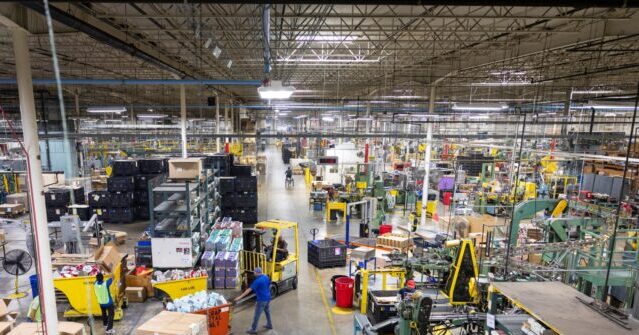U.S. factory orders fell in July as aircraft bookings continued their volatile pattern, but the underlying manufacturing sector showed steady demand with orders rising across most industries when transportation equipment is excluded.
New orders for durable goods totaled $302.8 billion in July, down from $311.6 billion in June, the Commerce Department said Monday. The decline followed a 9.4 percent drop in June, reflecting the lumpy nature of large aircraft orders that can swing monthly figures dramatically.
Stripping out the transportation sector, which includes aircraft and motor vehicles, new orders rose 1.1 percent to $201.1 billion in July after a 0.3 percent gain in June. That suggests manufacturers are seeing consistent demand for their products despite broader economic uncertainty.
The transportation-excluded figures better reflect the underlying health of manufacturing demand, showing steady if unspectacular growth.
Factory shipments, which represent completed production, rose 1.4 percent to $307.5 billion in July, with gains across most major categories. Excluding transportation, shipments increased 1.0 percent.
The volatile transportation sector saw new orders plunge 9.7 percent in July to $101.7 billion, driven largely by a 32.7 percent decline in nondefense aircraft orders to $19.1 billion. Despite the monthly swings, aircraft orders remain up 139.2 percent year-to-date, indicating the declines reflect timing rather than weakening demand.
Capital goods orders excluding aircraft, a closely watched indicator of business investment plans, rose 1.1 percent to $76.4 billion, suggesting companies continue investing in equipment and machinery.
Several core manufacturing sectors posted solid gains in July. Machinery orders increased 1.8 percent while electrical equipment orders rose 2.0 percent. Primary metals orders gained 1.5 percent, and fabricated metal products orders were up 0.7 percent.
The computers and electronic products category, which includes semiconductors, saw modest growth with orders up 0.6 percent and shipments rising 0.1 percent. Within that sector, communications equipment orders increased 0.9 percent.
Year-to-date performance shows the manufacturing sector’s resilience despite monthly fluctuations. Total durable goods orders are up 7.3 percent through July compared with the same period in 2024. Excluding transportation, orders are up 1.9 percent year-to-date.
Capital goods orders excluding aircraft are up 2.3 percent year-to-date, while overall capital goods orders have surged 20.3 percent, boosted by the strong aircraft performance.
The steady performance in core manufacturing aligns with recent employment data showing factories added 41,000 job openings in July, according to the Labor Department’s Job Openings and Labor Turnover Survey released last week.
Manufacturing has been supported by efforts by companies to bring production back to the U.S. and steady consumer demand for durable goods. However, the sector faces headwinds from elevated interest rates and global economic uncertainty.
The Federal Reserve has been monitoring manufacturing data as it weighs future interest rate decisions. While the central bank has kept rates elevated since the start of year, recent signs of economic cooling have led officials to signal potential rate cuts ahead.
Monday’s report suggests manufacturing demand remains on solid footing when accounting for the inherent volatility in large-ticket items like aircraft. The consistency in orders across machinery, metals, and electronics points to continued business investment despite economic headwinds.
Read the full article here


